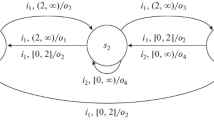Abstract
We discuss a special class of state machine specifications called Asynchronous Finite State Machines (AFSM) which allows the specification and synthesis of hazard-free control circuits under the unbounded delay model. AFSM are useful for the specification of sequential behavior involving choices. In contrast, models such Signal Transition Graphs (STGs) are more amenable to the specification of deterministic concurrent behavior.
AFSM specifications are transformed into STGs and then to State Graphs (SGs). At the SG level of representation, hazards can be identified as a type of violations of the Complete State Coding (CSC) property. Algorithms for obtaining SGs from AFSMs, and conditions for hazard-free implementation of SG derived from AFSM are discussed. A hazard-free synthesis technique from SG is described. A CAD prototype called CLASS (Cirrus Logic Asynchronous Synthesis System) has been built and used to successfully synthesize and verify the state machine benchmark from HP Laboroatories [1] and various other real applications.
Similar content being viewed by others
References
K.S. Stevens, S.V. Robinson, and A.L. Davis, “The post office—communication support for distributed ensemble architectures,” Sixth International Conference on Distributed Computing Systems, 1986.
T. Meng, R.W. Brodersen, and G. Messerschmitt, “Implementation of high sampling rate adaptive filters using asynchronous design techniques,”VLSI Signal Processing, III, Chapter 20, IEEE Press, 1988.
T.-A. Chu, “Synthesis of self-timed VLSI circuits from graphtheoretic specifications,”Proc. ICCD, IEEE, Oct. 1987, pp. 220–223.
T.-A. Chu, “Synthesis of self-timed VLSI circuits from graphtheoretic specifications,” Ph.D. Thesis, Dept. of EECS, MIT, June 1987. Also available as MIT Lab. for Computer Science TR 393, 1987.
A.J. Martin, “Compiling Communicating Processes into Delay-Insensitive VLSI Circuits,”Journal of Distributed Computing, Vol. 1, 1986, pp. 226–234.
C.H. van Berkel and R. Saeijs, “Compilation of communicating processes in delay insensitive circuits,”Proc. ICCD, 1988, pp. 157–162.
A.J. Martin et al., “The design of an asynchronous microprocessor,”Proc. of the 1989 Decennial Caltech Conference, ed. C. Seitz.
C. Seitz, “Self-timed VLSI systems,”Proc. Caltech Conf. on VLSI, Jan. 1979.
P. Beerel and T. Meng, “Gate-level synthesis of speed-independent asynchronous control logic,”Proceedings of ICCAD '92, Nov. 1992, pp. 581–586.
V.I. Varshavsky, et al.,Self-Timed Control of Concurrent Processes, Chapter 5, Boston, MA: Kluwer Academic Publishers, 1990.
L. Lavagno, K. Keutzer, and A. Sangiovanni-Vincentelli, “Algorithms for synthesis of hazard-free asynchronous control circuits,”Proc. DAC, June 1991.
C. Moon, P. Stephan, and R. Brayton, “Synthesis of hazardfree asynchronous circuits from graphical specifications,”Proc. ICCAD, Nov. 1991.
J. Ebergen, “Translation of programs into delay-insensitive circuits,” Ph.D. Thesis, Eindhoven Univ. of Technology, 1987.
T.-A. Chu and L.A. Glasser, “Synthesis of self-timed control circuits from graphs: an example,”Proc. ICCD, IEEE, Oct. 1986, pp. 565–571.
P. Vanbekbergen et al. “Optimized synthesis of asynchronous control circuits from graph-theoretic specifications,”Proc. ICCAD, 1990, pp. 184–187.
T. Meng, R.W. Brodersen, and G. Messerchmitt, “Automatic synthesis of asynchronous circuits from high level specifications,”Transactions on CAD, vol. 8, Nov. 1989, pp. 1185–1205.
S. Nowick and D. Dill, “Automatic synthesis of locally clocked asynchronous state machines,”Proc. ICCAD, 1991.
J.H. Tracey, “Internal state assignments for asynchronous sequential machines,”IEEE Trans. Electronic Computers, vol. EC-15, 1966, pp. 551–560.
L. Lavagno, C. Moon, R. Brayton, and A. Sangiovanni-Vincentelli, “Solving the state assignment problem for signal transition graphs,”Proc. DAC, June 1992.
T.-A. Chu, N. Mani, and C.K.C. Leung, “A new state assignment technique for asynchronous finite state machines,”Proc. DAC, Dallas, TX, June 1993, pp. 2–6.
T.-A. Chu, “CLASS: a CAD system for the automatic synthesis and verification of asynchronous finite state machine specifications,”Proc. Hawaiin International Conference on System Sciences, Special Track on Asynchronous Design and Systems, January 1993.
M.A. Kishinevsky, et al. “On self-timed behavior verification,”Proc. TAU '92, Princeton, March 1992.
D.B. Armstrong, A.D. Friedman, and P.R. Menon, “Design of asynchronous circuits assuming unbounded gate delays,”IEEE Trans. Computers, vol. C-18, 1969, pp. 1110–1120.
D. Dill, “Trace theory for automatic hierarchical verification of speed-independent circuits,” ACM Distinguished Dissertation Series.
Author information
Authors and Affiliations
Rights and permissions
About this article
Cite this article
Chu, TA. Synthesis of hazard-free control circuits from asynchronous finite state machines specifications. Journal of VLSI Signal Processing 7, 61–84 (1994). https://doi.org/10.1007/BF02108190
Received:
Revised:
Published:
Issue Date:
DOI: https://doi.org/10.1007/BF02108190




